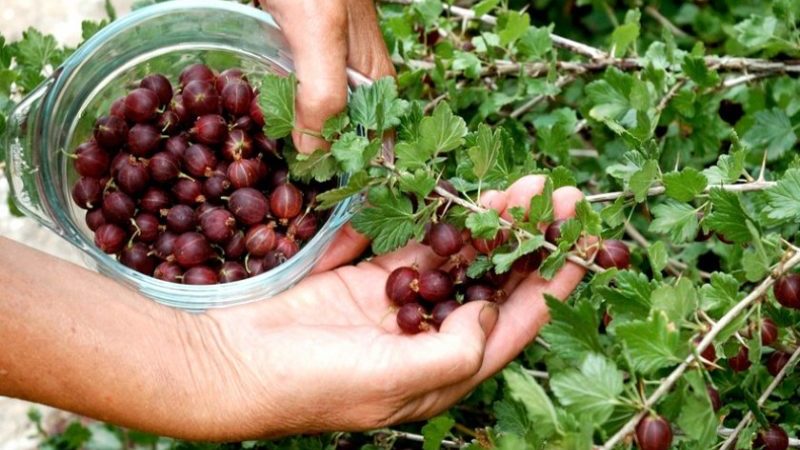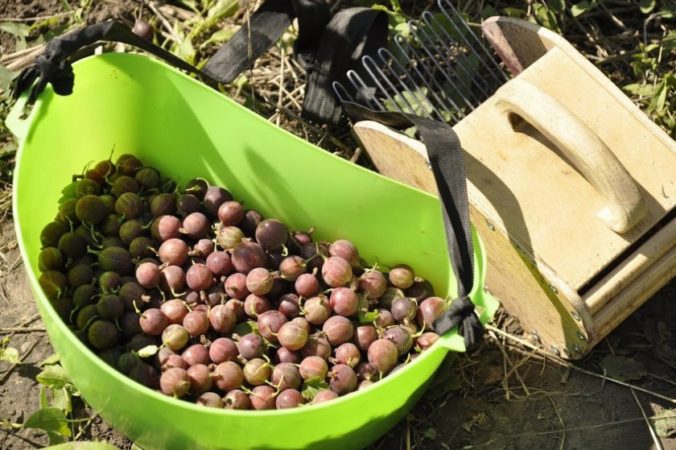When do gooseberries ripen and how to determine the degree of its ripeness
Gooseberries are popularly called northern grapes, because they grow throughout Russia, including the regions of the Far North. Various preparations are made from the fruits of this plant, so gooseberries of varying degrees of maturity are used. Ripening time depends on many factors, so proper harvesting requires certain knowledge. When the season begins, you will learn from this article how to determine ripeness and pick prickly gooseberries.
When do gooseberries ripen?

During the formation process, the berries are green, but as they ripen they gradually change color.
Depending on the variety, ripe fruit may be yellowish, red, light green or maroon.
The berries are ripening 1-2 months after the plants have flowered. Harvest from late June to August.
Reference. Shrubs bloom from April to June. In what month - depends on varieties.
What determines the timing of ripening?
The following factors influence the timing of ripening:
- Variety Early-ripening gooseberry varieties ripen first, and mid-ripening ones later. The last to be picked are berries from bushes of late-ripening varieties.
- Region. In the southern regions of the country, harvesting takes place earlier. There, spring warming occurs faster, which is why the shrub blooms relatively early. The harvest is harvested later in the north of Russia.
- Purpose of berries. Depending on their purpose, gooseberries are harvested at technical or biological maturity.
- The time of ripening is also influenced by the illumination of the bush., protection from winds, soil and air humidity levels. Berries that were planted on the south side of buildings and fences reach ripeness earlier.
- Regularity of watering, trimmings and fertilizing.
Approximate calendar dates of ripening
Gooseberries ripen in most cases in July. But the deadlines may shift by about 2 weeks in both directions. It all depends on the type of berry and the region where it grows.
Gooseberry ripening depending on the growing region
When are gooseberries harvested in different regions of Russia:
- In the Middle and Lower Volga region, as well as in the southern regions of the country, the first ripe berries appear at the very beginning of July.
- In central Russia In warm and hot summers, gooseberries begin to be collected in the second half of July. If the weather is unfavorable, the berries ripen about 2 weeks later.
- In hot summers with sufficient moisture in the Moscow region, the fruits ripen in the first ten days of July. If precipitation occurs frequently and the air temperature remains below the climate norm for a long time, maturity occurs at the end of the month. At the same time, gooseberries are harvested in the Northwestern District and Leningrad Region.
- In the Urals and Siberia, gooseberries ripen in early August. In these regions, experienced gardeners recommend planting mid-season varieties, and the shrubs themselves are placed only in well-lit areas.
If the berries are intended for jam, they are collected at the stage when the peel is still thick.
Depending on the variety
The time it takes to reach ripeness is also affected by the gooseberry variety:
- The most common early ripening ones are Salute, Cossack, Strawberry, Pink. If the weather is warm enough, they will ripen in the first half of July.
- Mid-season - Senator, Lyubimets, Northern Captain, Malachite, Krupny, Nekrasovsky. These varieties begin to ripen in mid-July.
- The most popular late-ripening ones are Charm, Folk, Northern Prince. They ripen in early August.
How to determine the degree of maturity
How to understand that gooseberries are ripe:
- Technical ripeness. The berries reach the sizes declared by the breeders. The color of the fruit is often lighter than that of fully ripe gooseberries. When technically ripe, the berries come off the stalk with little difficulty. The skin and pulp of gooseberries are dense and have a pronounced sourness.
- Consumer ripeness. The skin of the fruit becomes thinner and begins to show through a little in the sun. The berries acquire bright, rich colors. The fruits are juicy, soft, sweet.
Is it possible to collect unripe
Gooseberries are harvested green only if they require processing or require long-term transportation. Such berries can retain their taste and presentation for a long time.
Early harvesting reduces the load on the bushes, which reduces their depletion.
Important! Store unripe gooseberries only in the refrigerator or freezer. Otherwise, the berries will quickly spoil.
Will gooseberries ripen at home after picking?
Once harvested, gooseberries stop ripening, even if left for several days at room temperature.
It is advisable to pick berries only after they are fully ripened. Green gooseberries contain much less vitamin C and other useful substances.
Harvesting
Gooseberries are collected in several ways:
- hands;
- mechanical devices;
- comb method;
- using a plastic bottle.
Manually

The easiest way to pick berries from bushes is by hand. It will not be possible to collect large volumes in a day. But this method has a great advantage - the berries remain undamaged and retain all their beneficial properties and appearance. Also, the integrity of the fruit increases the shelf life.
Important! Before you start picking berries by hand, be sure to wear thick, long-sleeved clothing and gardening gloves. This will protect your hands from sharp thorns.
To carefully remove all the gooseberries from the bush, lift the branches one by one with one hand and collect the berries with the other, not forgetting the stalks.
Mechanical method
In the mechanical method, a special device is used - a vibrator. This is a convenient device that allows you to quickly collect all the fruits.
The principle of operation is mechanical action on the bushes. Under the influence of vibration, all the berries fall off.
The sequence of actions for this method of harvesting:
- Fabric, polyethylene or tarpaulin are spread under the bushes.
- The vibrator is installed and turned on.
- A stream of air is directed onto the fallen berries to remove debris.
- Remove all spoiled fruits.
- The berries are sorted.
This harvesting method has one big drawback: absolutely all the berries, including spoiled and unripe ones, fall from the branches of the bush.
Comb

The next method is with a comb:
- A thimble is placed on the thumb of the working hand.
- A device that looks like a comb with several teeth is attached to it. The length of each is approximately 1 cm, and the width is 0.7-1 cm. Usually this device is made with your own hands from wire.
- With one hand, lift the branch, and use the comb to move it towards you. The device picks berries. They fall into the palm.
To quickly collect in this way requires skill, which comes with experience.
Using a plastic bottle
On one side of the bottle, a hole is made in the form of a drop, which tapers towards the bottom, but does not reach it by about 4 cm. The container is secured to a rail or stick.
Collection is carried out as follows:
- The bottle cut is placed slightly below the berry.
- Hold the container towards you so that the gooseberries easily fall into the bottle. At the same time, it will come off the stalk.
- When the bottle is completely filled, the picked berries are poured into the main container.
How to pick gooseberries without getting pricked
To avoid injury when picking gooseberries, summer residents follow safety precautions:
- Clothes are worn only from thick fabric that can protect arms and legs from thorns.
- They pick berries while wearing gloves.
- If possible, use special devices that facilitate and speed up manual labor.
Storage and processing of berries
The main task when storing gooseberries is to protect the berries from high humidity. Shelf life depends on maturity:
- Well-ripened fruits can be stored in the cold for up to 5 days.
- If gooseberries were picked in dry weather, they remain fresh for 10 days.
- When picking unripe berries, the shelf life increases to 20 days.
- If the gooseberries are harvested at technical maturity and stored at zero temperature, they can be consumed within 3 months.
It is advisable to process the crop as quickly as possible. Fresh fruits are immediately sprinkled with sugar and sent to the refrigerator.
Most varieties of gooseberries are too sour to eat the fruits just like that. Only purple or overripe berries are considered sweet. But they are not transportable, so they cannot be found either on the market or in the store.
When heat treated, the fruits become sweeter even without sugar. Small gooseberries retain their flavor better than largeTherefore, it is used to make jams and sauces. Various types of wine are also made from gooseberries. They taste very similar to sherry.

How ripe should gooseberries be for jam?
For jam, gooseberries of technical maturity are used.
The dense berries make the most delicious preparations for the winter. They keep their shape well in sweet syrup.
In the Moscow region, fruits of early ripening varieties are harvested for jam in early July. In other regions, the dates are shifted by 2 weeks depending on the climate.
Conclusion
Gooseberries are an unpretentious crop with a high yield. It has 2 stages of maturity: technical and consumer. In the first case, the berries are used for preparing various dishes and jam, in the second - for fresh consumption.
Harvesting is difficult, so gardeners use various devices. Also in recent years, thornless varieties of gooseberries have become popular, for example, Nezhny and Senator.